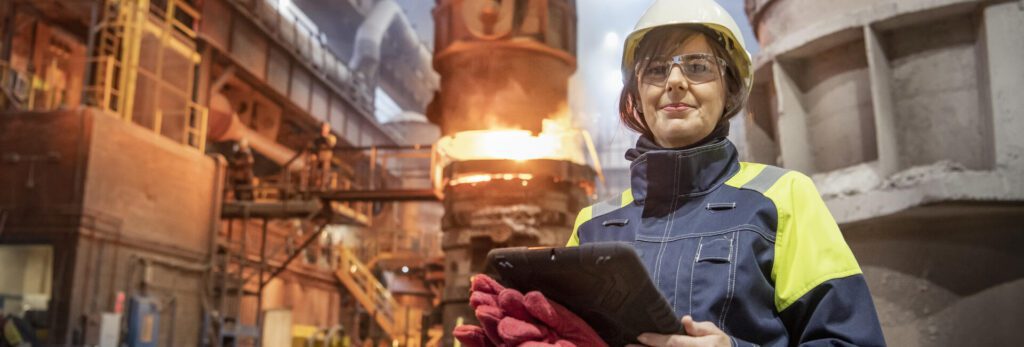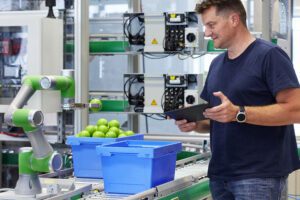
As global decarbonization momentum accelerates, organizations across the glass-making and steel-manufacturing industries are transforming their operations. This transformation involves a dramatic migration from fossil fuel to green electricity in glass making and from coal-fired blast furnaces to Electric Arc Furnaces (EAF) and Direct Reduced Iron (DRI) processes that use natural gas or green hydrogen in the steel industry. This move to the electrification of operations will allow these firms to lower carbon emissions dramatically.
The catalyst for driving the transition to more sustainable operations involves a mix of shareholder and customer demand, the threat of increasing regulatory penalties, and the rising cost of fuel due to the European energy crisis. In response to these pressures, global steel manufacturers, such as US Steel, have committed to achieving net-zero carbon emissions by 2050. In China, Baowu Group, the largest steel firm in the world, has promised a 30% reduction in carbon emissions by 2035.
Achieving such targets will involve the rapid migration to electrified furnaces across global operations. However, technological innovation will address only part of the CO2 challenge. Electrification and automation of operations must be consolidated and streamlined for core processes to be run more efficiently.
Critical to implementing this rapid change in operations will be the work performed by the process OEMs (pOEMs) who will be designing, building, and installing the new equipment or assets.
In the glass industry alone, with over 1,000 legacy container glass furnaces whose typical lifespan is 20 years, around 50 furnaces will need to be revamped each year. For pOEMs, rolling out new high-efficiency electrical furnaces at such a rate will be daunting. To take on this challenge and to service the magnitude of the demand across the steel and glass industries over the next few years, pOEMs will likely be motivated to establish new partnerships with suppliers who share both the vision and the capabilities to enable a decarbonized future for these heavy industries.
Partnerships enable rapid electrification time-to-market
Companies like Schneider Electric™ can support the growing demand for electrification across these critical industries. Working hand-in-hand with the pOEMs who are engaging in electrification-driven projects, Schneider Electric can offer support in three ways:
- Digital twin design tools – New simulation platforms enable pOEM electrical systems engineers to take the inputs from live electrical systems and run “what if” scenarios within digital twin software. Project risks are minimized during the design phase by generating scenarios of what will happen when changes are made to the electrical system. For example, what happens if a tiebreaker doesn’t open on a particular day or one of the two grid connections is lost? What if the system experiences a massive in-rush of current or a motor blows up, and a feeder is lost? Such capabilities significantly reduce system downtime by driving a more accurate decision-making process. Systems like the Schneider Electric ETAP PSMS tool offer capabilities in infrastructure upgrade projects’ design and operational phases.
- Process automation and power systems convergence – Traditionally, pOEMs had to buy into independent electrical and automation system packages. Still, many end users no longer view these two core systems as individual silos. Corporate executives recognize an opportunity to eliminate redundant systems and processes, reduce CO2 emissions, and share data and tools across engineering and design projects. If properly engineered, the physical linkages of facility power and process systems strengthen operational resilience and accelerate disaster recovery time should a catastrophic event occur.
By integrating across the same communications backbone, power and process convergence reduces CapEx costs by removing a significant volume of the hardwiring needed to support independent assets. Since the automation interfaces communicate via a “soft-wired” converged backbone and no longer through a physical wire, the need for a high volume of IO cards is eliminated, drastically reducing cost. Such an approach can also increase the engineering efficiency of the pOEM. For instance, when a variable on the power side is created, it can be easily imported to the process side, with no need to go through the time-consuming consistency-checking process. - Microgrid deployments – Electricity is high-efficiency energy and a vital enabler of lower glass, steel, and industry CO2 emissions. New-generation microgrids can ensure reliability and provide access to renewable and traditional grid energy integration. Combining the management of hydrogen, wind, and solar power with standard grid power−energy utilization can be optimized to perform in a low-cost, reduced-emissions manner. Such solutions enable pOEMs to increase their competitive edge by offering end users low-risk, high-return solutions that can be quickly delivered.
For more information
The next post will discuss how pOEMs can leverage new energy-related operational services to drive long-term revenue for glass and steel manufacturers. To learn more about how you can help your customers accelerate their carbon emissions reductions and reduce their energy costs, download our Green Steel and Green Glass handouts.



